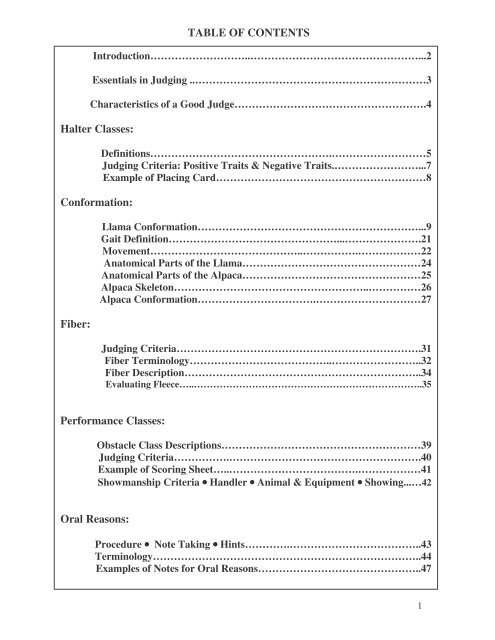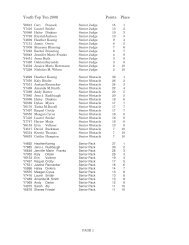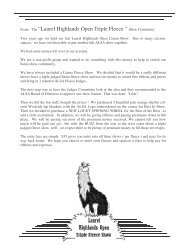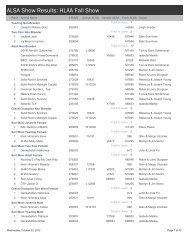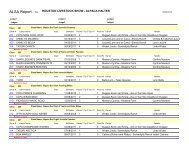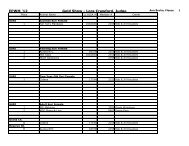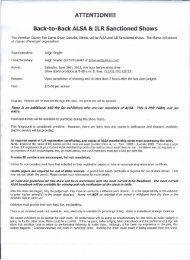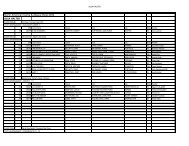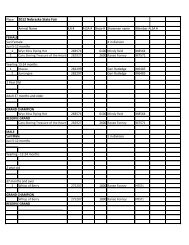Youth Judging Manual - Alpaca Llama Show Association
Youth Judging Manual - Alpaca Llama Show Association
Youth Judging Manual - Alpaca Llama Show Association
You also want an ePaper? Increase the reach of your titles
YUMPU automatically turns print PDFs into web optimized ePapers that Google loves.
TABLE OF CONTENTSIntroduction………………………..…………………………………………...2Essentials in <strong>Judging</strong> ..…………………………………………………………3Characteristics of a Good Judge……………………………………………….4Halter Classes:Conformation:Fiber:Definitions…………………………………………….………………………5<strong>Judging</strong> Criteria: Positive Traits & Negative Traits.……………………...7Example of Placing Card……………………………………………………8<strong>Llama</strong> Conformation………………………………………………………...9Gait Definition…………………………………………...………………….21Movement……………………………………..…………….………………22Anatomical Parts of the <strong>Llama</strong>……………………………………………24Anatomical Parts of the <strong>Alpaca</strong>……………………………………………25<strong>Alpaca</strong> Skeleton………………………………………………..……………26<strong>Alpaca</strong> Conformation…………………………….…………………………27<strong>Judging</strong> Criteria…………………………………………………………….31Fiber Terminology…………………………………..……………………..32Fiber Description…………………………………………………………..34Evaluating Fleece…..……………………………………………………………..35Performance Classes:Obstacle Class Descriptions…………………………………………………39<strong>Judging</strong> Criteria…………….……………………………………………….40Example of Scoring Sheet…..……………………………….………………41<strong>Show</strong>manship Criteria • Handler • Animal & Equipment • <strong>Show</strong>ing...…42Oral Reasons:Procedure • Note Taking • Hints………….………………………………..43Terminology…………………………………………………………………..44Examples of Notes for Oral Reasons………………………………………..471
INTRODUCTIONEver wonder why a particular animal places first (or last)? Ever wonder why somebodychooses to buy one animal over another? Participation in the ALSA <strong>Youth</strong> <strong>Judging</strong> Programcan help you develop the knowledge to answer these questions yourself. .By participating in <strong>Judging</strong> Contests, you will develop skills and train your eyes toobserve all aspects of animals and makecomparative selections. This will provide you with a sound basis for development within thelama community and may be the spark that leads to your being an ALSA Judge in the future.The basic principles of conformation and soundness apply to all livestock. Althoughthis program is specifically geared to llamas and alpacas, the general knowledge to be gainedfrom participating will help you in evaluating whatever livestock you choose. To excel atthis, or any livestock judging, you must have a strong desire to know and understand theanimal and devote time and energy studying the materials. The skills involved in thinkingclearly, making decisions knowledgeably and defending accurately those decisions, withconcise, orderly reasons, help develop confidence and maturity that will assist you in allfuture endeavors.We encourage any group of young people, with parents and leaders, to use this manualtowards the end of holding <strong>Youth</strong> <strong>Judging</strong> Clinics and <strong>Judging</strong> Contests, either as standalone events or in conjunction with local, regional, state and national stock shows. <strong>Llama</strong>associations, as well as 4-H Clubs and FF A Chapters, will find this program in keeping withtheir goals of activity, growth, development of skills and rewards for our youth.Through judging, you can learn to:• use correct terminology• analyze animals accurately• describe and compareanimals• arrive at definite decisions• support decisions with clearand concise statements.2
ESSENTIALS OF JUDGING.<strong>Judging</strong> is:1. Evaluating a lama on its type, qualityconformation, movement, soundness, fiber quality and dispositionrelative to:a. Its intended purposeb. How closely it approaches theideal lama2. Being able to assess the relative“excellence” of two or more lamas.<strong>Judging</strong> clinics, organized by 4-HGroups, FFA Chapters, or interested llamaand alpaca associations are designed to give.Participants knowledge of conformation andsoundness of animals as well as methods,rules and other essentials of’ judging. Visitsto farms, shows and auctions Will give youopportunities to see and evaluate largernumbers of lamas. Remember, you’re notlooking for how they are alike, but howthey’re different. You’ll learn what is a representative,sound, conformationally correctlama. In all our judging classes, there will befour lamas.Because judging is based onobservation, analysis and decision-making,you must first know what you’re looking for.You will learn the parts of the animal andhow important each part is in relation to thewhole, based on anatomy and function. Thereare no clear-cut, right/wrong, and black-whiteanswers in judging. You must:1. Know what you’re looking at, andfor, and why.2. Be honest, open-minded and fair.3. Learn to balance your “ideal” with thebest over-all package, faults and all.4. Practice, practice, practice. 3
CHARACTERISTICS OF A GOOD JUDGE1. Judges are knowledgeable. Theyknow what type of lama they’re lookingfor: what their ideal is. . Theyrecognize good free movement: howthe feet and legs are supposed to worktogether. They know where to lookfor faults, unsoundness andblemishes.2. Judges have keen powers ofobservation. They know how to lookat a class and where to stand to seewhat they need to see. They havelearned to observe and evaluate thewhole lama and all his parts.3. Judges have learned to makecomparisons. They compare eachlama to their ideal as well as to theother lamas in the class. They knowhow important a fault, or good point,is and how strongly to consider it inmaking their decision. They havelearned to see not only that they havea difference, but how different it is.4. Judges are able to make decisionsquickly. Taking a long time to make adecision may lead the audience andthe entrants to think you’re not sure.Developing your. Knowledge oflamas, your powers of observation,and your ability to make comparisons(the first three (characteristics) shouldenable you to make timely, informeddecisions.5. Judges defend placings with reasons.A good set of reasons is dependenton:a. accurate observation.b. an effective vocabulary of relevantterms.c. an orderly system.d. the ability to convey yourthoughts in a convincing manner.(In this program, juniors will givereasons in writing in response toquestions. Intermediates will givereasons orally based on, but withoutthe benefit of notes.)6. Judges possess integrity. Never letanything other than the lamas in yourclass influence your decisions. Thehandler (unless you are judging aperformance class), the audience, oryour own knowledge of how aparticular animal has placed previouslyshould be neither a positive nornegative factor in your decision makingprocess.7. Judges are always positive. Rememberthat your job in the show ring is toselect the best lama in the class, not theworst. You mustspend a lot of time learning the correctparts of the lama and how they interact.But you must also learn about thedeviations from these norms. Althoughyou must discuss faults in your reasons,you must give equal weight to thepositive characteristics that offset thesefaults. .4
Soundness:HALTER CLASS DEFINITIONSFree from flaw, defect,disease or injury.Unsoundness :Physical disability thatprevents the animal frombeing used for the purposeintended.Conformation: Appropriate arrangementof body parts.Balance: Proportionate shape or contour ofthe animal.Blemish:. A noticeable imperfection that doesnot affect the function, purpose orsoundness of an animal.Movement: A reflection of the balance andconformation of an animal.Disposition: Mental attitude of an animalshowing willingresponsiveness.Condition: Amount of finish or fat onan animal.Style:Height:The blending together of all body parts. intoan attractive package.Measured at the highest. point of the withers(top of shoulders) or hip (top of rump).You must formulate a picture of theideal lama in your mind. Trying tojudge lamas without first fixing thisimage in your mind is like trying todrive a car without a steeringwheel.BreedingUnsoundness: Any condition preventing amale from impregnatingthe female or the femalefrom delivering live,normal young.5
OverallAppearance: Should be symmetrical, wellbalanced and proportionedfor .age.JUDGING CRITERIA: POSITIVE TRAITS.Head: <strong>Llama</strong>: The head should becarried proudly and alertly.Front:Rear:Note:<strong>Alpaca</strong>: The head should be. short, thick, triangular andsymmetrically formed. Earsshould be erect, fine andspear-shaped. .Both should have jaws withproperly aligned teeth.Neck should be in proportionwith body. Front legs shouldbe straight with forward facingtoes and strong, uprightpasterns.Side view: Rear legs shouldbe relatively straight fromhock to fetlock joint.Rear view: Rear legs should. be straight from hip tofetlock.Toes should be forward facingand pasterns should be strongand uprightBecause of their use as packanimals, llamas are held tostricter adherence to theseleg conformation standards.Movement: All limbs should move freelyand smoothly in a correctlyaligned pattern.Body: Back should be strong, and have areasonably straight topline.<strong>Llama</strong>s should have adequatewidth and depth of chest, fullnessof heart girth, and arch to the ribs(spring of rib).Fiber: The fiber should exhibit. healthycondition, uniformity, fineness , anddensity.Note: Because they are used primarily forfiber production,’ alpacas areheld to higher and differentstandards for fiber. Please seeadditional criteria at <strong>Alpaca</strong>Fiber.ReproductiveOrgans: Intact male testicles shouldboth be visible and uniformin both size and placement.They should be of adequatesize for the age of the lama., Female genitalia should appearnormal and of adequatesize for age.Eye Appeal:Style, presence, and woolcoverage may all contributeto the eye appeal of theanimal.Disposition: A pleasant and tolerantdemeanor is highly desirable.6
Angular Limb Deformity:Excessive lateral or medial deviationof the bones and joints of the front andrear legs.Hump Back:An increased convexity of upwardcurvature of the topline of the back.Sway Back:An increased concavity or downwardcurvature of the top line of the back.Scoliosis:Lateral curvature of spine and/or tail.Post-Leggedness:Essentially a straight line from thestifle joint to the fetlock without thenormal zig-zag pattern of the hind legjoints (as viewed from the side).Dropped Fetlock or Pastern:A weak pastern, possibly resulting inthe fetlock and/or pastern touching theground.Cow Hocked:The hocks are too close to the middleline as viewed from behind.Sickle Hocked:An exaggerated zigzag pattern of thehind leg joints.Body Condition:Excessive thinness or obesity.JUDGING CRITERIA: NEGATIVE TRAITSSERIOUS FAULTSEtopic Testicles:One or both testicles not found intheir usual location.Jaw Malocclusions:The upper jaw is too short or the lowerjaw is too long, contributing to protrudinglower teeth. Occasionally thelower jaw is too short or the tipper jawis too long.Female External Genitalia Abnormalities:The lips of the vulva may be morehorizontal rather than the normalvertical plane. The tip of the clitorismay be tipped up or too small.Umbilical Hernia:A soft bulge at the site of the umbilicus.Ears:Short, stubby ears that are not due tofrostbite. Banana ears are typical ofllamas but not desirable in alpacas.Gonadal Hypoplasia:Smallness of either one or both testicles.Discussion of faults should bepresented in comparative terms onlyand in as positive a manner aspossible.YES: Lama #1 has a stronger top linethan lama #2.NO:Lama #2 is swaybacked.7
EXAMPLE OF PLACING CARD<strong>Judging</strong> Contest Placing CardContestant #______ Class #_______Class Name______________________CheckPlacings Placing1.2.3.4.....................11.2.4.3.....................21.3.2.4 .....................31.3.4.2 .....................41.4.2.3.....................51.4.3.2.....................62.1-3.4.....................72.1.4.3.................... 82.3.1.4.................... 92.3.4.1................... 102.4.1.3................... 112.4.3.1................... 123.1.2.4................... 133.1.4.2................... 143.2.1.4................... 153.2.4.1................... 163.4.1.2................... 173.4.2.1................... 184.1.2.3................... 194.1.3.2................... 204.2.1.3................... 214.2.3.1................... 224.3.1.2................... 234.3.2.1................... 24Tabulator’s Score _______8
CONFORMATION DRAWINGSFigure 2: Conformation Diagrams. Toplines & Pelvic Attachment of a<strong>Llama</strong> and <strong>Alpaca</strong>2A: Angle of attachment(400) of the pelvis tothe spine on a llama./28 Angle of attachment(500) of the pelvis tothe spine on analpaca/9
Figure 3: Conformation Diagrams. Foreleg, Side ViewThe llama’s center of gravity is near the shoulder. Therefore, the primary purpose of theforelegs is to hold up weight. From a side view the bone structure should be almost. perpendicular to the underline of the body. A “vertical,” or “perpendicular,” is an imaginaryline drawn from the shoulder joint through the front limb to the ground.3A Normal 3B Camped UnderCamped BackWhen viewed fromthe side, the foreleg isbehind the “vertical”orperpendicularExcessive pressures areexerted on forwardaspects of the joints.The tendons on backside of leg are stretched.3C Camped out in FrontCamped ForwardThe foreleg is ahead ofthe “vertical.”Not as serious as beingcamped under. Theweight of the animal isadequately supported.Causes some restrictionin stride length.No negative impacton forward balance.Forward balanceis impaired.10
Figure 4: Conformation Diagrams. Foreleg, Side View4A Straight Legged PostLeggedThe bones making up thehind limb are straight upand down. Very littlecushion in the limb.All the forces are directedthrough the joints, causingcompression to the bones.Arthritis would be theultimate consequence.4B Too Much Angulationof the ShoulderWeakens the limb.Ligaments and muscles ofthe shoulder will experiencemore than their shareof the forces applied to thelimb.4C Dropped Fetlock Downin the Fetlock WeakPasternThe normal angle of thepastern should be 40-55degrees.The support structure ofa dropped fetlock is.stretched. .The appropriate angle tothe pastern, one of themore importantcushions in the limb,has been lost.11
Figure 5: Conformation Diagrams - Foreleg, Side View5A Buck Knee12The knee is bent forward,tendons and muscles, aswell as the bone structureof the foreleg, are in theposition of an animal thatis traveling downhill.Gravity is directed downwardand forward fromthe knee, instead ofthrough the cannon bone.The knee lacks stability.The ligaments of the.kneeare stressed.The animal isimproperly balanced,unstable, moresusceptible to stumblingand falling.58 Calf KneeThis is a serious fault inconformation. The kneeis bent backward, awayfrom the vertical line,between the ankle andthe upper part of theforearm.The muscle and tendon.structure of the leg is ina constant position of ananimal traveling uphill.A contributing factor tothe unsoundness of thepastern joint and ankle.Angular pressures areexerted on the forwardside of the bones in theknee and tension isplaced on supportingligaments. Arthritis isthe potential result.5C Cocked AnkleA serious conformationalfault.The relationship of thecannon bone to the pastern istotally out of position.
Figure 6: Conformation Diagrams. Foreleg, Front ViewFrom a front view you should be able to draw a vertical line from the point of the shoulderthrough the center of the knee joint, continuing down through the center of the ankle andbetween the two toes on the ground.6A Normal6B Base WideForelegs are angled outfrom the perpendicularwith the feet placedfurther apart than the topof the limb.Provides stability butrestricts the free flowingmovement of the limb,and diminishes the efficiencyof gaits.When in motion, thelegs will “scribe in anarc.”6C Base NarrowForelegs are angled intowards theperpendicular, with feetplaced closer togetherthan the top of. the limb.Reduces stability.In motion, the animalwill tend to “ropewalk.”13
Figure 7: Conformation Diagrams. Foreleg, Front View7A Slight Knock KneeThe knees angle inslightly.In motion, the forelegswill appear to “wing in”a bit.7B Moderate KnockKneeThe inward angle ofthe knees is morepronounced.Instead of a freeflowing movement,the forelegs willnoticeably “wing in.”7C Severe Knock KneeThe knees are severelyangled in.Structurally unsound,marked reduction ofmobility14
Figure 8: Conformation Diagrams. Foreleg, Front View8A Bowed LegsThe leg curves outwardly atthe knee. This can occur inanyone, or all four limbs.In motion, the leg(s)will tend to “scribe anarc.”8B Splay FootedWhen viewed from the.front the pastern istwisted outwardly fromthe vertical midline ofthe limb.This can occur atanyone of the joints (theshoulder, elbow, knee,or fetlock)and can be seen in oneor both front legs.Commonly associatedwith knock knees. .In motion, this results in agait known as “dishing” or“winging in.”8C Pigeon ToedWhen viewed from thefront, the pasterntwists. inwardly fromthe vertical midline ofthe limb.This can occur atanyone of the joints.15
Figure 9: Conformation Diagrams. Rear Leg, Side ViewIn the rear, the “vertical” or “perpendicular” is an imaginary line drawn from the hip jointdirectly through the back of the hock joint, to the ground behind the rear foot.9 A. Normal9B Camped Out BehindThe limb is positionedbehind thevertical.Impairs balance,stability, andmaneuverability.9 C . Camped UnderBehindThe limb is positioned infront of the vertical.Impairs balance,stability, andmaneuverability.16
Figure 10: Conformation Diagrams. Rear Leg, Side View10A Straight Legged PostLeggedVery little cushion inthe limb.All the forces aredirected through thejoints, causingcompression to thebones.This animal would not beable to sustain work overa long period of time.Arthritis would be -theultimate consequence.108 Sickle HockWeakens the limb.Places excessive stresson the ligaments of thehock.The efficiency of thehind limb movement isimpaired.17
Figure 11. Conformation Diagrams • Rear Leg, Side Leg ViewA closer look at sickle Hock vs Camped Under Behind. These faults are sometimes mistaken for one another.11 A. Normal 11 B. Sickle Hock 11 C. Camped UnderBehindThe cannonbone on the hindlimb is usuallyslightly offvertical.Weakens the limb.This places excessivestress on the ligamentsof the hock. Theefficiency if the hindlimb movement isimpaired.This limb ispositioned in frontof the vertical.Impairs balance,stability andmaneuverability.18
Figure 12: Conformation Diagrams. Rear Leg, Rear ViewAt the rear the “vertical” is drawn from the hip joint through the hocks tothe ground behind. the center of the back of the foot.12A Normal12B Cow HocksThe points of thehock are closerto the midlinebecause of twistingof the hindleg.12C Base WideProvides stability,but restricts freeflowing movementof the limb anddiminishesefficiency of gaits.When in motion,the legs will scribein an arc,12D Base NarrowReduces stability.In. motion, theanimal will tendto “rope walk”(appear to betrying to balanceon a tight rope.)19
Figure 13: Conformation Diagrams. Non-Limb Problems.13A. NormalThe lower front teeth press against thehard pad on the upper jaw to shearforage.The cheek teeth are arranged so that theupper and lower rows mesh to provide anefficient grinding surface.13B Shortened Upper Jaw in an AdultMale <strong>Llama</strong>The fore part of the upper jaw isshortened. ..’-“. . _.13C Elongated Lower Jaw in an Adult<strong>Llama</strong>The lower jaw is lengthened out ofposition so that the cheek teeth don’tmesh.13D Shortened Upper Jaw in a Baby<strong>Llama</strong>20
GAIT DEVIATIONSNormal GaitDishing. Winging OutScribing an ArcRope Walking21
MOVEMENTMovement is probably the most criticalpoint of evaluation for a Judge to utilize, asalmost every serious conformational fault andstrength will be pronounced in the animal onthe move. As you spend more time evaluatinganimals, you will learn most of your judgingwill become clear to you as you view theanimals on the move. Also, remember to takeinto consideration llamas do not always moveout easily on their own, one at a time. Theynormally walk more freely following others;also, babies are still not comfortable in thering and often drag and resist moving well.<strong>Llama</strong>s normally do not giveyou a good view at the trot. .Good handlers have the ability to concealfaults with their adept maneuvers and poseswhile standing, but those characteristics willbe obvious as the animal moves around thering or changes positions in line. This is a goodreason to attempt to keep an eye on the entireline up, or to quickly view the entire group onthe move in a circle; this allows you acomparative moving view. Moving a fewanimals which appear to be very close in adifficult class, often gives you an advantage inmaking the placements. This also gives theexhibitors and audience the opportunity to seethe same points you will mention in your oralreasons.POINTS TO REMEMBER:This is a PACING animal and the normalfluid gait is best adapted to an animal which isnot so broad as to inhibit the movement of thelong forward reaching rear limbs. These limbsare set close to the midline of the body tominimize the side to side rolling which isnecessary to shift the center of balance.MOVEMENT as a reflection of thebalance and correctness of the structure of theanimal will be in a straight forward linemoving off all four feet from a square pattern. .GAIT is a reflection ofconformation. Lameness is indicatedby an alteration in the gait. It can becaused by a structural change thatresults in a shortened stride orpeculiar way of swinging the limb.Or it can be a painful gait described asfollows;Swinging leg lameness: Pain associatedwith swinging the limb while moving. Usuallyinvolves muscles, tendons or ligamentsthat are stretched during locomotion.Supporting leg lameness: Pain whenpressure is applied to bones and joints whenthe limb strikes the ground. Shilling leglameness: When multiple limbs areinvolved in a painful condition that makesthe lama appear lame in one limb one dayand another limb on another day.Excerpts from work of Dr. Murray Fowler,DVMSome terms to consider;Impact: A striking of one thing againstanother Compression: To squeezetogether, to make smaller by pressureThrust: To push with forceTorque: A force causing rotationCushion:. Something to counteract orabsorb a sudden shock, jar or jolt.Compensation: An increased activity ofone organ to make up for weakness or lossof another organ.Elasticity: Having the ability to spring backto an original size or shape.Excerpt from work of Dr. Murray Fowler,DVM22
.Movement of animals should be viewed from the profile, or side view for:Overall balance in body and stride ...... rump and tail set .fluid, easy movement ...... flexibility of hockstrength of the top line ...... strength of pasternsjuncture of neck to body ...... angulation of the shoulder/hip/hockExamples: short, choppy stride. = straight shoulder= post leg= short hip lengthlong, over reach stride = too much angle to hock/hip= low tail set/sloped rump= short torso/long hip lengthMovement as viewed from the rear may indicate:rear feet pointed out = close at hocksfront toes pointed outview over the top/spring of ribwidth between back legs= stiffness of hocks= close at knees= turned out fetlocks= body capacity= fluid, easy movement= in line with front= body capacity= straight rear legs= base wide/base narrow= rope walk/cross-overMovement as viewed from the front may indicate:Front toes pointed out = close at the knees= twisted at the kneesRear toes pointed outKnees moving to outside ofnormal straight lineWidth between front legs= turned out fetlocks= cow-hocked= long toe nails= stiff hocks= excessive chest width= obesity= loose shoulders= excessive twist to fetlocks= narrow, restricted= movement base= narrow/base wide obesity= loose shoulders23
Terms Used To Designate Superficial Areas Of The Body Of A <strong>Llama</strong>1. Poll2. Ear3. Forehead4. Eye5. Face6. Nostril7. Upper Lip8. Muzzle9. Lower Lip10. Muzzle11. Jaw12. Throatlatch13. Neck14. Shoulder15. Arm16. Elbow17. Forearm18. Knee19. Cannon or Shank20. Fetlock21. Pastern22. Nail23. Pad or Slipper24. Ribs25. Chest or Breast26. Withers27. Back28. Loin29. Tail Head30. Tail31. Thigh32. Stifle33. Gaskin34. Hock35. Hind Cannon36. Scent Gland24
TERMS USED TO DESIGNATE SUPERFICIAL AREAS OF THE BODY OFAN ALPACA1. Poll2. Ear3. Forehead4. Eye5. Face6. Nostril7.Upper Lip8. Mouth9. Lower Lip10. Muzzle11. Jaw12. Throatlatch13. Neck14. Shoulder15. Arm16. Elbow17. Forearm18. Knee19. Cannon or shank20. Fetlock21. Pastern22. Nail23. Pad or slipper24. Ribs25. Withers26. Back27. Loin28. Croup29. Tail Head30. Tail31. Thigh32. Stifle33. Gaskin34. Hock35. Hind Cannon36. Scent Gland25
ALPACA SKELETONA Eye Socket (orbit)B. Jaw (mandible)C. Cervical VertebraeD.Shoulder blade (scapula)E. ShoulderF. Arm (humerus)G. ElbowH. Forearm (radius)I. Knee (carpus)J. Shank (cannon)K. FetlockL. PasternM. Breastbone (sternum)N. RibsO. Loin (lumbar vertebrae) P.SacrumQ.Tail (coccygeal vertebrae)R. Pelvis.S. HipT. Leg Bone (femur)U. Knee cap (patella)V. StifleW. TibiaX. HockY. Sesamoid Bone26
.ALPACA CONFORMATIONFigure 1. Side view:normal, sites to observeclosely are pointed outFigure 2. Sideview: crouchedFigure 3. Side view:camped forward infrontFigure 4. Side view:camped rearward in frontFigure 5; Sideview: buck kneedFigure 6. Side view: calfkneeFigure 7. Side view:camped forward behindFigure 8. Side view:camped rearwardbehindFigure 9. Side view:Sickle hocked27
ALPACA CONFORMATIONFigure 10. SideView: post leggedFigure 11. Side view: shortlegsFigure 12. Side view: longlegsFigure 13. Side view:long neck, long face, Xcocked ankle, Y. Downin fetlockFigure 14. Side view:short neckFigure 15. Side view:sway backed, long ears28Figure 16. Side view:humped back, long ears
ALPACA CONFORMATIONFigure 17. Use of a plumb lineto determine straightness ofA front and B. rear limbFigure 18. Front-view: A moderate knock-kneed, B. severeknock kneed, C. pigeon toed, D. splay footed, E. normal, F.base narrow, G. base wide and H. bow legged. Similarstances may be observed on the rear limbs from a rear view.Figure 19. Diagrams of dental anatomy. A normal relationship of incisor teeth to thedental pad, b. short lower jaw or parrot mouth (inferior brachygnathia), C. and D.elongated lowerjaw (inferior, prognathia) E. parrot mouth and F. dental pad.29
ALPACA CONFORMATIONFigure 20. Ideal conformation,illustrated within rectangles. Theneck rectangle is the length of theleg.Figure 21. Legs too long, illustratedwithin rectangles.Figure 22. Legs too short, illustratedwithin rectangles.Figure 23. Neck too short,illustrated with rectangles.30
ALPACA FIBER: JUDGING CRITERIAAccording to the emphasis guide, in FullFleece Halter classes the fleece is equal to50% of the judging with soundness,conformation and alpaca type being 50%. InShorn Halter the fleece is equal to 20% ofthe judging; soundness and conformation isequal to 80%. <strong>Judging</strong> is done on a relativeor comparative basis using the positive andnegative traits and the emphasis guide.UNSHORN HUACAYA FLEECE.POSITIVE TRAITSThe following traits are not necessarily inorder of priority.A Hand.B. Fineness.C. Density.D. Uniformity of density, fineness andcrimp/crinkle throughout the blanket.E. Character including crimp.F. Condition and quality of fiberthroughout the fleece and lock.G. Abundance (fiber coverage overall).H. Absence of guard hair in blanket.I. Sheen.UNSHORN SURI FLEECEPOSITIVE TRAITS. The following traits are not necessarily inorder of priority.A Hand.B. Luster.C. Consistent lock formation.D. Density.E. Character without crimp.F. Fineness.G. Uniformity of lock formation andfineness.H. Condition and quality of fiberthroughout the fleece and lock.I. Abundance (fiber coverage overall).J. Absence of guard hair in the blanket.NEGATIVE TRAITS1. A tender staple with pronounced weaknessor a break along the length of the fibers.2. Lack of uniformity within the fleece andthe lock.3. Brittle fiber.4. Presence of parasites.5. Matting or cotting.6. Excessive guard hair.7. Stress Breaking - weakness and breaking ofall fibers in the lock at the same point.8. Weathered - showing cotting and pitting atthe tips.9. Dung tags10. Vegetable matter and debris.31
FIBER TERMINOLOGY32APRON: Coarse fiber which forms an overcoat around the chest of the alpaca.ARCHITECTURE: Pertaining to the fleece:the general structure and lay of fiberswithin the locks which go together tomake up the fleece as a whole.BELLY FIBER: Fiber harvested from thebelly, usually of a coarser quality.BLANKET: The back and side of a fleecefrom. the base of the neck to the base ofthe tail and the sides from the back boneto the belly including the haunches.BREAK: A weakening of fibers in the staplewhich will break under strain.BRIGHTNESS: The property by which fiberreflects light.BRITCH FIBER: Fiber off the lower thighof the rear leg of the alpaca.BRITTLE FIBER: Long tapering dry tipsusually caused by weathering.BURRY FIBER: Fiber contaminated withburrs (seeds, etc.)CARPET FIBER: Coarse hairy fiber. .CLASSING: Grouping of fleeces accordingto type and quality.. CHARACTER: The characteristics of fiberlock or fleece determined by qualitativeevaluation of crimp, staple length andconfiguration, handle or softness, and.luster. It indicates good breeding andgrowth.CONSISTENCY: Uniformity throughout afleece of fineness, staple length, character(crimp, ‘staple configuration, hand)and density.COARSE: Fiber of large diameter and lowcount.COTTED: Fiber naturally felted on theanimal.COUNT: Refers to Bradford Count, amethod of indirectly assessing fiberdiameter.COVERAGE: The distribution of continuouslygrowing fiber over the alpaca’sbody, neck, legs and head.CRIMP: The waviness found along thelength of the individual fibers throughoutthe blanket. The waviness in crimp occursuniformly in the fibers of the lock inthe same plane.CRUTCHINGS: Fiber from the britch andinner thighs.CURL: Waviness found along the length ofindividual fibers throughout the blanketthat lies randomly in different planes andgives the fleece a curled lookingappearance, e.g. Suri alpacas.DAGS: Lumps of dung.DEBRIS: Material that can be foundcontaminating a fleece.DENSI1Y: Number of fibers per square unitmeasurement of the alpaca’s body.ELASTICITY: The ability of a fiber torecover it’s original size and shape afterextension.FELTING: The irreversible tangling offibers together.FLEECE WEIGHT: The yield or weight ofthe spinnable fiber from shearing. To berelevant, the age of the alpaca, the particularshearing (Le., first or subsequent)should be identified and the length oftime the fleece was on the animal.FIBER FINENESS: Refers to the fineness ofthe individual fiber and is measured inmicrons
GENERAL TENDERNESS: Fibers break in. random locations along the fibers.Indicates generally weakened fleece.GUARD HAIR: The somewhat thicker,straighter and longer fibers found in thefleece.HANDLE OR HAND: The tactile quality ofthe fleece to the hand.LOCK: A naturally occurring tuft of fiberwithin the fleece.LUSTRE: The sheen, gloss or shine of thefleece and fiber. .MATTING: The inextricable meshing offibers in: the fleece.MICRON: A unit of measurement equal toone thousandth of a millimeter. .MUSHY: Fiber lacking in character. Reecewool with weathered and worn tips whichcause irregularity of fiber length inprocessing.NOILS: Tangles that occur as a result ofshort fiber contamination.OPEN FLEECE: A type of fleece (asShetland sheep or camelids) which doesnothang together as a unit and tends to havelower grease content, as opposed to aclosed coat (for example, Merinos andmost fine wooled breeds of sheep) wherethe wool surface does not open and ischaracterized by high grease content.PRIME FIBER: The best quality fiber that aparticular alpaca has to offer. This mayinclude some neck fiber.SECOND CUTS: Short pieces caused bypoor shearings. .SEEDY FIBER: Fiber containing seeds.SKIRTING: Fiber of lower graderemovedfrom fleece.SILKNESS: Smoothness and slipperinessof fiber.SOFTNESS: The tactile quality of the fleece.SORTING: Breaking of a fleece up intoqualities.SOUND: Fiber without breaks or tenderness.STAPLE: Single lock of fiber.STAPLE LENGTH: The average length of.fiber within the fleece when measuredfrom its point of origin at the animals skinto the tips of the individual fiber.STRESS BREAK: occurs at one pointacross the fibers in the locks.SUN BLEACHING: The changing ofcolor of the tips of locks when exposedexcessively to the sun. This can also bethe cause of damage by drying out thetips of locks and causing tenderness atthe tips.TIPPY: A form of lock which indicates thefibers within the lock are not all close tothe same length. The more “tippy” the lockthe greater the disparity in the fiber length.Since fiber growth rate in the blanket .isroughly inversely proportional to thediameter of the fiber, a lock with a widevariety of fiber lengths will also have awide variety of fiber diameters, that is tosay, an inconsistent lock.TENDERNESS FIBER: Weakness in thefiber. It may be general, which results inbreaks at random places in the fibers in thelock under tension, or it may be a stresstenderness, where all of the fibers break inthe same place along their length,indicating something happened at onepoint in the growth of the fleece toproduce a break at that point.UNIFORMITY: Refers to the degree. of consistencyfrom one area to another .withinthe fleece of fineness, staple length,character (crimp, staple configuration,hand) and density. .YIELD: The amount of. clean fiber obtainedfrom a particular alpaca. 33
ALPACA FIBER DESCRIPTIONSFiber StructureCortical CellExpression of CrimpWide Medium NarrowMean DiameterScale Height.- SmoothSerrated edges of scalesSuri ScalesStronger(tighter)Weaker(open)Expression of DensityHuacaya ScalesMedullated FibersClosed(Less skin shows)Open(More skin shows)a b c d e34
EVALUATING FLEECE / FIBER ON THE LIVEANIMALA OVERALL VIEW1. General Appearance for Type andStyle related to Huacaya or Suri.2. Obvious Positive Traits / ObviousNegative Traits.a. Density / Openness.b. Coverage over body parts.3. Comparisons within the class group.B. HANDS-ON1. Approaching the Animal andhandler.2. Establishing the first impression /substantiate your opinion. .3. HANDBOOK stated criteria relativefor each species.4. Quiet, gentle approach and hands5. Handling for Body Condition andover-all density of coverage byhands.6. 3 location~ for opening and appraisingthe fiber:a. Point of shoulder.b. Mid-Line of Side.c. Point of Hip.7. Overall uniformity and Coverage.8. Absence of guard hair.9. Effects of Grooming / Condition andcleanliness.a. Clean, washed fleece should not bepenalized if the Architecture ofthe Lock and the Fleece throughoutmay still be evaluated.b. Animals presented with extremeamounts of debris may be penalizedif it interferes with the appraisalof the fiber characteristicsor detracts from the over-allgeneral appearance of the animal.c. Acknowledgment of <strong>Show</strong> Ringsas Public Presentations should be. .made by a Judge.C. Huacaya Fiber / Fleece Characteristics:1. . Fleece must be carefully parted andopened to allow vision of the skin forassessing the DENSITY, or numberof fibers in a given area, and howmuch of the skin line is exposed toindicate the openness of the fleece.2. At the same time, an appraisal is madeof the CRIMP and/or Crinkle presentand is evaluated for:a. the Narrowness of the Zig-Zag. b.the Tiqhtness or openness of theZig-Zag.c. the Expression/Extension of thecrimp from the skin to thetips.d. the uniformity of theCrimp/Crinkle throughout theindividual fibers and through theentire fleece.3. HAND And FINENESS must beappraised throughout the fleece and itis important to understand they arenot always in direct correlation, asHand does not always indicate Fineness,since it may be related to thesheen (or luster) coating each strandor to the presence of hairs.35
D. SURI FIBER I FLEECECHARACTERISTICS:1. SURl locks should be gently lifted fromthe ends upward to expose a portion ofthe skin where the lock definition anddensity of locks may be viewed. Fiberwhich is matted at the skin will notform locks, and older fleeces mayexhibit this characteristic..2. LOCK DEFINITION: the incidenceof individual locks along a portion ofskin.a. Definition at the skin and at theend of the lock.b. Distinctness of the definition.c. Feathering or fanning out at theskin - may be due to fleece age onthe animal, the degree of finenesswithin the fleece, or a lack of lockdefinition.d. Type of lock formed - may differand should not be penalized unlessit is obviously a result ofintermediary fibers with little Suridistinction.e. Narrowness of the defined lockrelative to overall appearance.. Flat Locks may appear wider asthey do not form any twist; it is thedefinite definition of the lockwhich is most important.f. Uniformity of the locks through””out the fleece from front to rear.3. LUSTER: The shine or brilliancereflected from individual fibers andlocks.4. HAND: Associated with the feel ofsoftness and relative to the luster andfineness within the fibers.5. LENGTH of locks relative to age,growth rate and shearing date.6. ABSENCE of CRIMP within thelock.7. Condition and Quality should not. beaffected by Washing correctly; Surifleece which has been blow-dried mayexhibit matting and lack definition of thelocks.8. Expression and Appearance of the fiberon the neck and lower leg may often bean indication of the type and quality oflocks, especially on animals which havebeen shorn and not grown back to havethe length of formed lock on the blanketarea.E. Balancing CONFORMATION ANDFIBER/FLEECE.1. 50 / 50.a. Select for Conformation first.b. Select for Fiber first.2. Degree of differentiation from idealfor positive and negative traits.3. Heritability of traits.4. Comparisons within the class group.F. ORAL REASONS to confirm and explain:1. The OBVIOUS traits.2. The unseen characteristics and theirrelative imp0rtance.3. Breed characteristics specific toHuacaya or Suri.4. ACCURACY of statements.5. USE of Correct, accurateTERMINOLOGY.36
Viewed from the left sideLegs: The dividing line between leg fiber(hair) and blanket fiber (prime) may shift upand down a little from alpaca to alpaca. Fiber is on the outside of the legs only.The further the dividing line is situated down the leg, the better. Leg fiber is grade 3 or thirds.Nape of Neck: Where the neck joins into the withers. Occasional guard hair or intermediatefiber should not migrate onto the back at the withers. This would result in contaminationof the blanket.Mid Back: This is an imaginary line down the middle of the back dividing the blanketinto left and right sides. There should be no obvious weathering found along theline of the mid-back.37
Viewed from the rear:Tail: Fiber on the tail is usually grade 3 or thirds, with guard hair.Britching: Area around the underneath of the tail. This is usually lesser quality fiberthat can have fecal and urinary staining.Hocks: This area is also susceptible to staining.38
OBSTACLE CLASSThe purpose of an obstacle class is todemonstrate a well trained lama’s obedienceand willingness to complete the activitiesrequested by the handler. The lama should beshown in a clean, well-fitted halter and lead.The lama should follow the handler throughthe course on a loose lead. How manyattempts are allowed at each obstacle andwhat constitutes an attempt will bedetermined by the class Judge. When morethan one attempt is allowed, a successfulcompletion after the first attempt will stillincur the penalty points for the first refusal.There will be four entries to judge in theobstacle course. The exhibitor will attempt acourse consisting of 10 obstacles, each ofwhich will be worth a potential 10 points.PERFORMANCE CLASSESDEFINITIONSCourse: The course may be located indoors,outdoors, or a combinationof the two, and mustinclude the minimum requiredobstacles.Off Course: Forgetting an obstacle, taking anadditional obstacle, taking anobstacle out of sequence fromthe posted course or intentionallyskipping an obstacle or specificrequirement.Deviations: Taking an obstacle backwards,taking multiple jumps in thewrong order, going in or out ofthe wrong door of the trailer, etc.Loose Lead: The handler has his/her hand onthe lead rope in such a way thatthe handler’s hand is relaxed athis/her side. The lead rope inthis description usually forms a“J” from the lama’s head to thehandler’s hand.The lead rope is persistentlystretched tight from the handler’shand to the lama’s head.Tight Lead: The handler’s hand is close tothe lama’s head, resulting in restrictedmovement of the lama’shead and neck.Short Lead: The lama plants all four feet refusingto budge.Refusal: The lama will not respond topressure on the lead rope tomove forward. The lama stepsto the side of the obstacle toavoid the obstacle. The lamatakes a step backward from theobstacle. .39
JUDGING CRITERIAHANDLER ERRORS, INCLUDING,BUT NOT LIMITED TO:1. Tight lead.2. Short lead.3. Dangling free end of lead rope.4. Inattentiveness to lama.5. Too slow of a pace through thecourse.6. Improper attire or footwear.MINOR FAULTS, INCLUDING BUTNOT LIMITED TO:1. Touching of obstacles.2. Too wide or too tight in turn’s.3. Slow response to handler’s request.4. Inattentiveness of the lama.5. Bad disposition or unwillingness.MAJOR FAULTS, Including BUT NOTLIMITED TO:1.Refusing an obstacle.2 Knocking down of poles, jumps, orother obstacle parts.3.Stepping out of obstacleconfinements.4 Extreme nervousness or spooking.5. Rushing ahead of handler on enteringor exiting an obstacle.6. Failure to execute a complete stop.7. Deviation from course.INCOMPLETIONS:1. Not closing a gate.2.Missing a pole in a weaving obstacle.3. Not completing any in a series ofjumps.4. Not backing all the way.5. Not loading all four feet in a vehicleor trailer.6. Failure to change pace when requested.7. Jumping off side of bridge or ramp(without a subsequent successful attempt).8. Entering, but not successfully completingor exiting any obstacle or activity.40
PERFORMANCE CLASS SCORING SHEET<strong>Youth</strong> Performance ScoringScore numerically 1-10 (with 10 being perfect) on each obstacle41
SHOWMANSHIPThe following criteria are the basis for yourjudging a class in showmanship. They areguidelines that you should already be followingin your own showing.Criteria<strong>Judging</strong> <strong>Show</strong>manship class will have fourentries. As the Judge, you will consider thehandler’s ability to show his or her animal to itsbest advantage at halter. <strong>Judging</strong> is based on theexhibitor’s basic skills in training, fitting,grooming and following directions, as well asstyle and ability in presenting the animal to theJudge for evaluation. The conformation of theanimal is NOT to be considered.HandlerHandler’s attire should be neat, clean,conservative and appropriate for the class. Inaddition, the handler should be promp, alert,confident, poised and courteous. Exhibitorsshould be natural. Overshowing, and unduefussing and maneuvering are objectional.Exhibitors should be courteous andsportsmanlike at all times. The handler shouldnot converse with other exhibitors nor withpeople outside of the arena.The LamaThe animal should be clean and free of debris,in good condition, with trimmed toenails. Thehalter and lead should fit properly and be clean,in good repair and safe. The lama should toleratetouching of the body, parting of the fleece andexamination of the teeth.SHOWINGExhibitors should follow theseguidelines during showmanship classes:DO: maintain a safe distance betweenanimalsDON’T: crowd or touch othersDO: lead the animal from the left sideDON’T: lead from the right sideDO: hold the lead in his/her right hand atleast 8 inches from the halterDON’T: hold the lead close to the halteror so far away as to lose control.DO: hold the excess lead in a figure eightin the left hand.DON’T: coil the lead around the left handor let the end dangle.DO: set up the lama squarely on all fourfeet, stand facing the lama at a 45degree angle off its left shoulder,move smoothly from side to side,passing in front of the lama as thejudge moves around and be aware ofhis/her position relative to the judgeat all timesDON’T: obstruct the Judge view of thelama.The animal should be trained tolead out at a brisk pace and tostand quietly in a balancedposture.A handler should never berewarded for efforts in showinga poorly trained animal.42
Having been to lama shows, you areaware that the Judges give oral reasons to theaudience to explain their reasons for placing aclass. The ability to make a spontaneouspresentation is a learned skill and determinedstudy of the following suggestions anddescriptions will assist you in mastering thistechnique.PROCEDURESIn each class of four lamas, you will referto the top (1 & 2), middle (1 & 3) and bottom(3 & 4) pairs. An adequate vocabulary ofappropriate terms is necessary. Oral reasonswill be limited to two minutes.I. Identify the class (Yearling Females)and state your placings.2. Explain briefly why your top placeanimal wins the class. .3. Using concise, comparative statements,discuss the strengths of each lamaover the one placed lower. (1 over 2,2 over 3, etc.)4. If a lower placing animal is stronger insome area (but not overall) than thenext higher animal, grant the lesseranimal that strength.5. Since similar points of conformationmay be used in discussing each pair, avariety of terms will keep yourpresentation interesting.6. Conclude your statements identifyingthe class again and restate yourplacement.7. Use correct terminology, (see 32-33).8. Make accurate comparisons, basedon the facts of the class. If you are notsure of a point, omit it rather than begraded down for inaccuracy.9. Train yourself to see the class in yourmind as your give you oral reasons.ORAL REASONSNOTES FOR ORAL REASONSIntermediates will be allowed to takenotes during the judging of the halter class.These notes may be used when preparing topresent reasons. No notes will be permittedduring the reasons presentation. Use a notecard (4” x 6” or the one supplied by ALSA)and make short statements to serve as remindersof why one animal placed overanother. Be sure to include ‘grants’ in caseswhere the lower placing animal in the pair isbetter on a single point or two than the higherplacing animal. This makes the owner of thelower placed realize that the Judge did lookat their animals and the animal has positivepoints.DO•Talk directly to the Judge.• Maintain eye contact.• Wear your “showmanship” attire.Talk in a conversational tone,speaking clearly and distinctly.DON’T• Slouch or shift your weight. .Chew gum.•Wear caps or hats.• Stand too close to the Judge.43
ORAL REASONS TERMINOLOGYGeneral AppearanceDesirable.................... UndesirableBalanced.................... Not balancedMore stylish.................... PlainStraighterlined.................... SlackframedMore eye appeal ................. UnattractiveFlashier.................... Coarse featuredMore structurally correct ......…… Poorly balancedMore feminine.................... Too masculine (feminine)More masculine.................... Too feminine (male)A more pleasing packageMore elegantMore regalRegal in appearanceEye catchingMore correct proportionsProper balancePresenceAttractiveMost strikingImpressiveToplineDesirable .................... UndesirableStraighter topline .................... Weak topStronger top .................... Low frontedLeveler topline .................... High behindStronger back or loin.................... Round rumpHigher tailset .................... Low tailsetMore nearly level rump................ Drooped rumpMore correct rump set .................. Weak loinBody CapacityDesirable.................... UndesirableDeeper body.................... Shallow bodiedBolder spring of ribs.................... Rat ribbedDeeper hearted.................... Shallow heartedWider front.................... Narrow frontLonger ribbed.................... Shallow chestMore correct width upfront................ Narrow chestLonger body.................... Too wide frontBulldog front Narrow top Short bodied44
ORAL REASONS TERMINOLOGYFront Leg StructureDesirable ....................UndesirableCorrect set...................BowleggedCorrect set at knees ....................Knock kneedStronger pastern ....................Weak pasternsMore flexible pastern..................Soft pasternsMore cushion upfront Pigeon toed (in)Freer gaitBuck kneed (over)Freer strideCalf kneed (back)Freer movementSplayfooted (out)Correct stridePigeon Toes (in)Rear Leg StructureDesirable.................... UndesirableCorrect setSickle hockedMore correct angle to hock Post leggedFreer strideToo straight behindMore mobileWeak pasternsFreer movementSoft pasternsCorrect strideShort pasternsMore collected strideOpen hockedTruer strideToo close at hocksLonger strideRope walkingMore agileStraddles behindShort -stridedFleeceDesirable .................... UndesirablePleasing HandLess Desirable HandleApparent finenessNot fineMore fineCourseFinestStrongMore denseLooseExcellent densityOpenGood uniformity of densityLacks uniform densityUniform crimp throughout blanketLoses crimp in the shoulder/rumpExcellent fiber coverageLacks fiber coverage on the lower legsVery typey in fiber coverage and shape of Not typey in shape of head and earhead and muzzlePoor conditionHigh sheenExcessive vegetable matterHealthy conditionTender staple45
ORAL REASONS TERMINOLOGYFleeceGeneral DescriptionsIndication of a higher-yielding fleece:Evidence of density as expressed by weight of locks appears more voluminous byits airy, loft softness , yet may be lower yielding Fleece which exhibits waviness incomparison to defined zig-zag in crimp. Extension of crimp throughout the lengthof lock structure Stronger (or weaker) in expression of fleece character visuallyappealing in phenotypic appearance more prominent in the expression of lock(s) ordefinition .Loss of lock definition at the skin due to fineness of fiber exhibits more(or less) uniformity from front to rear in characteristics such as density, crimp,fineness <strong>Show</strong>s more (or less) integrity of fiber (which means soundness) Lack ofcontinuity Dominant in balance between conformation and fiber characteristicsMore legitimate in balancing positive traits of conformation and fiberless prominent emphasis of negative traits Stronger (or less dominant)In expression of . . . Crimp or lock or character46
ORAL REASONSEXAMPLE OF REASONS GIVEN FOR A HALTER CLASS<strong>Judging</strong> Contest Placing CardContestant#__21_Class#_1_Class Name juvy heavy wool female1.2.3.4 .…………... 11.2.4.3 .................... 21.3.2.4 .................... 31.3.4.2 .................... 41.4.2.3 .................... 51.4.3.2 .................... 62.1.3.4 .................... 72.1.4.3 … ............... 82.3.1.4 .................... 92.3.4.1 ................... 102.4.1.3 ................... 112.4.3.1 ................... 123.1.2.4 ................... 133.1.4.2 ................... 143.2.1.4 ................... 153.2.4.1.................... 163.4.1.2 ................... 173.4.2.1 ................... 184.1.2.3 ................... 194.1.3.2 ................... 204.2.1.3 ................... 214.2.3.1 ................... 224.3.1.2 ................... 234.3.2.1 ................... 24Tabulator’s Score________Your reasons presentation need not be long. Infact, it will be limited to two minutes. Stateclearly the reasons you placed the class as youdid.Contestant Number_______ HalterClass#_______Reasons3 over 2straighter top tine,more correct balance.moves more correctly inboth front & rear2 over 4smoother gait,better length of neck,More substance of body4 over 1More correct angle of the hips,straighter top line,shows more ring presenceGrants2 over 3finer more dense fiber& smooth gait4 over 2a straight top line,Ring presence1 over 4correct front legs,A pleasing dispositionIn this example, the placings were 3-2-4-1. The contestantfelt that animal #3 was the best in the class. Animal #2 wassecond and so on. The notes form class # 1 could be used toput together the following set of “reasons”.“I placed this class of Juvenile Heavy Wool Females 3-2-4-1. Animal # 3 has a stronger, top line, more correct top lineand moves more correctly in front and rear. Granting #2 hadmore dense fiber and a smooth gait.I placed #2 over #4 because #2 had a smoother gait, betterlength of neck and more substance of body. I will grantthat #4 has a straight top line and ring presence.I placed #4 over # 1 because #4 has more correct angle ofthe hips, straighter top line and shows more ring presence.Granting that # 1 has correct front legs and a pleasing disposition.For these reasons, I placed this class of Juvenile HeavyWool females 3-2-4-1.47
48NOTES


